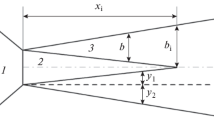Abstract
Noise is generated from a flow field upstream of a shock wave periodically discharged from a pipe end. A vortex ring and an underexpanded jet are periodically formed and diffused downstream. To clarify the mechanism of the noise generation, the flow field was experimentally and numerically studied. The flow field was visualized mainly by the schlieren method and the sound pressure of the noise was measured. The pulsatile flow through the pipe was numerically simulated by Random-Choice Method and using these results as the boundary condition, the pulsatile jet was simulated by TVD scheme. As a result, a good qualitative agreement was found between the flow field obtained by the calculations and that by the experiments. Furthermore, a relation between the behaviour of the vortex ring and the generation of the noise was discussed.
Similar content being viewed by others
Abbreviations
- e :
-
total energy per unit mass
- F :
-
frictional force per unit mass
- h :
-
enthalpy
- n :
-
rotational speed of the rotary valve
- p :
-
pressure
- Q :
-
heat transfer per unit volume
- r :
-
internal radius of pipe
- t :
-
time
- td :
-
time measured from the instant when the shock wave reaches the end of the pipe
- u :
-
velocity for x-direction
- v :
-
velocity for y-direction
- x :
-
axial distance
- y :
-
radial distance
- Γ :
-
ratio of specific heats
- ρ :
-
density
- κ :
-
heat conductivity
- μ :
-
viscosity
- τ :
-
period of one cycle of the rotary valve, or shear stress
References
Endo, M. and Iwamoto, J., The Influence of Wave Action on Mass Flow Rate through Pipes, SAE Paper, 911724 (1991).
Takayama, K. et al., Shock Wave Development and Propagation in Automobile Exhaust Systems, SAE Transactions, 880082 (1989), 4.66–4.72.
Futagami, Y. and Iwamoto, J., A Study on the Relation Between Pulsating Flow and the Noise, SAE Paper, 961822 (1996).
Yasunobu, T. et al., Numerical Analysis of Flow Caused by Emission of Compression Wave from Open End of Circular Tube, Trans. JSAE (B), 62–596 (1996), 1313–1320 (in Japanese).
Endo, M. and Iwamoto, J., A Numerical Study of Pulsating Flow in a Duct with a Junction, SAE Transactions, 911783 (1992), 1482–1487.
Sakakibara, Y. and Iwamoto, J., Numerical Study of Self-Excited Oscillation of Supersonic Jet Impinging on Plate, Proceedings of the International Conference on Computational Engineering Science, (1995), 1059–1064.
Author information
Authors and Affiliations
Additional information
Masaki Endo: He received his BSc (Eng), MSc (Eng) and Ph.D. (Eng) degree in Mechanical engineering in 1988, 1990 and 1993 from Tokyo Denki University, re-spectively. He was supervised in Pulsating Flow in Pipe by Prof. J.Iwamoto, or co-author. He took up his position as assistant at Tokyo Metropolitan College of Tech-nology in 1993. In 1996 he was promoted to assistant professor of mechanical engineering at Tokyo Metropolitan College of Tech-nology. His research interests have been expanded to phenomena in unsteady high speed flow field with shock wave.
Assistant Professor of Mechanical Engineering, Tokyo Metropolitan College of Technology. Junjiro Iwamoto: He received his BSc (Eng) and MSc (Eng) degree in Mechanical engineering in 1962 and 1966, respectively, from College of Engineering, Keio University, and his Ph.D. in High-Speed Oscillatory Flow in 1970 from Keio University. He worked as an engineer for Toyota Motor Company from 1962 to 1964. He took up his position as assistant professor at Tokyo Denki Uni-versity in 1969. In 1980 he was promoted to professor of mecha-nical engineering at Tokyo Denki University. His research interests include high-speed flow, shock dynamics and pulsating flow. Professor of Mechanical Engi-neering, Tokyo Denki University.
Rights and permissions
About this article
Cite this article
Endo, M., Iwamoto, J. A study of pulsatile jet discharged from pipe end. J Vis 1, 261–269 (1999). https://doi.org/10.1007/BF03181407
Received:
Revised:
Issue Date:
DOI: https://doi.org/10.1007/BF03181407




